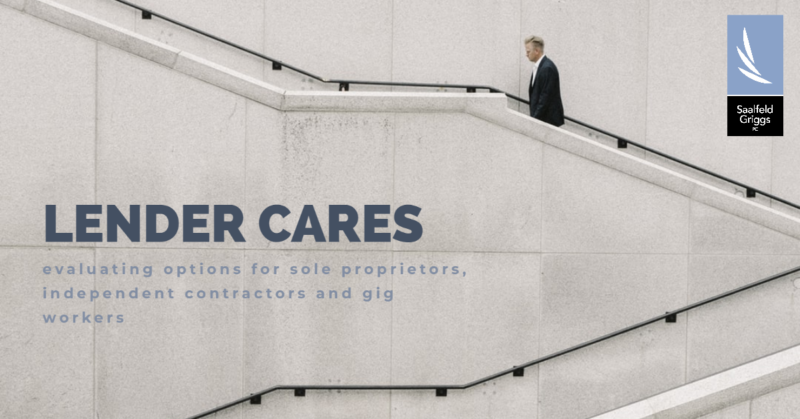By Erich Paetsch, Creditor’s Rights & Bankruptcy and Litigation Attorney
When the Coronavirus, Aid, Relief and Economic Security (CARES) Act became law on March 27, 2020, government support programs were made available to independent contractors and other small businesses decimated by COVID-19 and the public health response. In a rapidly changing environment, many of these small businesses are turning to community lenders for help navigating access to these programs.
As every lender is all too aware, the CARES Act creates a new loan program called the Paycheck Protection Program or PPP. While the PPP loan program continues to evolve daily, the CARES Act makes clear that the PPP loan is intended to support small businesses with under 500 employees with certain narrow exceptions tied to affiliation rules. Recognizing that the economy relies upon the contributions of sole-proprietors, independent contractors and gig workers, the CARES Act includes within the definition of eligible businesses these parties. Because the PPP loan program relies upon the support of community lenders around the country, lenders are now confronted with understanding not only the PPP loan program but also how that program overlaps with other relief under the CARES Act to help customers.
In its guidance, the U.S. Small Business Administration (SBA) has set a rolling start date for when participating lenders may accept applications for PPP loans from independent contractors and gig workers. Already doing everything possible to accommodate the initial application surge for PPP loans starting on April 3, 2020, independent contractors and gig workers are now also eligible to apply for PPP loans with their community lenders starting on April 10, 2020. The SBA has made clear in its guidance that independent contractors should apply directly for assistance under the PPP loan program. For example, in its frequently asked questions, the SBA notes that payments made by an eligible business to independent contractors and sole proprietors should not be counted in determining the eligibility amounts under the PPP loan program. Instead, those independent contractors and sole proprietors should apply for a PPP loan themselves.
A significant benefit behind the PPP loan program is an opportunity to convert a portion or perhaps all the sums borrowed under the PPP loan into a forgivable grant. While clear regulatory guidance is lacking on how forgiveness will work, the CARES Act and the limited available guidance from the SBA states that PPP loan forgiveness is primarily tied to keeping and paying employees over an eight-week period following disbursement of the PPP loan to a borrower. Lenders are required to disburse funds within 10 days of PPP loan approval. Seventy-five percent of the forgiven amount under any approved PPP loan is tied to retaining or returning to pre-pandemic employee and salary numbers. Consequently, for sole-proprietors, independent contractors and gig workers, returning to work and paying themselves promptly after receiving a PPP loan is crucial to receiving any anticipated forgiveness under the PPP loan program.
In addition to the PPP loan, the CARES Act separately provides another avenue for assistance to independent contractors and gig economy workers. Ordinarily, workers who are self-employed, independent contractors and gig workers do not qualify for unemployment insurance. However, the CARES Act creates “Pandemic Unemployment Assistance” to provide unemployment benefits to certain workers traditionally ineligible for unemployment benefits.
The CARES Act permits an individual who is self-employed, an independent contractor or a gig worker to apply for and receive unemployment benefits if they self-certify that he or she is able and available to work within the meaning of applicable state law and is “unemployed, partially-unemployed or unable or unavailable to work” because of one or more of the following COVID-19 related reasons:
- They are diagnosed with COVID-19
- They have symptoms of COVID-19 and is in the process of seeking a medical diagnosis
- A household member has been diagnosed with COVID-19
- They are providing care to a household member with COVID-19
- A child or other person in the household for which the individual is the primary caregiver is unable to attend school or daycare to COVID-19
- The individual is unable to reach work due to a quarantine
- The individual is unable to attend work because of healthcare professional advised self-quarantine
- The Individual was required to quit their job due to COVID-19
- The individuals place of employment closed due to COVID-19
- The individual is self-employed, is seeking part-time employment, and does not have sufficient work history or otherwise would not qualify for unemployment benefits under another state unemployment program
Many states are now rapidly taking steps to adopt and implement this expanded unemployment benefits program at a time when unemployment applications are already vastly exceeding historic application numbers. In many cases, states are waiting on additional Department of Labor guidance on how to implement this new system before making the benefits available. Understandably, many states’ unemployment systems are also strained to the breaking point trying to implement the new benefit system while coping with record-shattering application numbers.
Under the CARES Act, the typical unemployment benefits available to all eligible applicants including sole-proprietors, independent contractors and gig workers is expanded in both duration and amount. The CARES Act extends the benefits period by 50 percent, permitting eligible unemployed workers to collect benefits for up to 30 weeks. Under the CARES Act, an additional $600 weekly benefit is provided in addition to each States weekly benefit amount. However, this added benefit is only available to unemployed workers during the eighteen-week period spanning March 30, 2020, to July 31, 2020.
With sole-proprietors, independent contractors and gig workers eligible to receive both expanded unemployment insurance benefits and to obtain a PPP loan the intersection of these two programs requires hard choices. For example, if loan forgiveness is a priority after receiving a PPP loan, an individual is no longer eligible for unemployment benefits because forgiveness is tied to the employee using the PPP loan to pay compensation to that individual. Because it is likely that the forgiveness period and the additional unemployment insurance benefit of $600 per week will overlap, each impacted individual should carefully evaluate which program provides the best economic benefit for them. In addition, intangible considerations related to the timing of the lifting of stay at home orders and start-up challenges for sole-proprietors and independent contractors are necessary. Evaluating and weighing out the choices is critical to making the best possible decision during an unprecedented period.
A community lender cannot make decisions or instruct sole proprietors, independent contractors or gig workers what is the best decision for them. However, as anxiety and uncertainty impact decisions, community lenders find themselves helping navigate the turbid waters of this pandemic. Lenders are assisting their customers to understand not only the rapidly evolving PPP loan process but are also uniquely situated to alert those customers about the impact decisions they make might have on other benefits under the CARES Act. While each customer has a unique decision they must make, lenders and their customers can work collectively to make sound and informed decisions that are critical ensuring a successful return to normalcy.
Erich Paetsch is a partner in the Creditor’s Rights & Bankruptcy and Litigation practice groups, and the Financial Services and Construction industry groups. The information in this article is not intended to provide legal advice. For professional consultation, please contact Erich at epaetsch@sglaw.com. 503.399.1070. © 2020 Saalfeld Griggs PC


